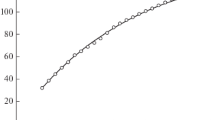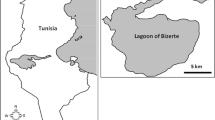Abstract
The golden mussel, Limnoperna fortunei, is an invasive freshwater bivalve. Since its introduction to Argentina, it had caused damage to the native fauna as well as economic damage to industries of the region. Here, we describe the growth of L. fortunei in a natural temperate environment in Argentina. Age was estimated according to the modal progression method. The constants in the von Bertalanffy growth model were adjusted by an iterative algorithm. Three annual cohorts had similar growth rates. The estimated t 0 for each cohort showed a temporary displacement in relation to the spawning period.
Similar content being viewed by others
References
Boltovskoy, D. & D. Cataldo, 1999. Population dynamics of Limnoperna fortunei, an invasive fouling mollusc, in the Lower Paraná River (Argentina). Biofouling 14: 255-263.
Blanchard, A. & H. M. Feder, 2000. Shell growth of Mytilus trossulus Gould, 1850, in Port Valdez, Alaska. Veliger 43: 34-42.
Choi, S. S. & J. S. Kim, 1985. Studies on the metamorphosis and the growth of larva in Limnoperna fortunei. Kor. J. Malacol. 1: 13-18.
Darrigran, G. & I. Escurra de Drago, 2000. Invasion of Limnoperna fortunei (Dunker, 1857) (Bivalvia: Mytilidae) in America. Nautilus 2: 69-74.
Darrigran, G. & G. Pastorino, 1995. The recent introduction of a freshwater Asiatic bivalve, Limnoperna fortunei (Mytilidae) into South America. Veliger 38: 171-175.
Darrigran, G., S. Martín, B. Gullo & L. Armendáriz, 1998. Macroinvertebrates associated with Limnoperna fortunei (Dunker, 1857) (Bivalvia, Mytilidae) in Río de la Plata, Argentina. Hydrobiologia 367: 223-230.
Darrigran, G., P. Penchaszadeh & M. C. Damborenea, 1999. The life cycle of Limnoperna fortunei (Dunker, 1857) (Bivalvia: Mytilidae) from a Neotropical temperate locality. J. Shellfish Res. 18: 361-365.
Darrigran, G., P. Penchaszadeh & C. Damborenea, 2000. An invasion tale: Limnoperna fortunei (Dunker, 1857) (Mytilidae) in the Neotropics. Proc. 10th International Aquatic Nuisance Species and Zebra-Mussels Conference, Toronto, Canada. 2000: 219-224.
Guerrero, C. A. & A. Tablado, 1985. Programa básico para la descomposición de distribuciones polimodales. Bol. Asoc. Cienc. Nat. Litoral 5: 45-52.
Guerrero, R., C. Lasta, E. Acha, H. Mianzan & M. Framiñan, 1997. Atlas Hidrográfico del Río de la Plata. Comisión Administradora del Río de la Plata-Instituto Nacional de desarrollo Pesquero. Buenos Aires-Montevideo: 109 pp.
Haag, W. R. & D. W. Garton, 1992. Synchronous spawning in a recently established population of the zebra mussel, Dreissena polymorpha, in western Lake Erie, U.S.A. Hydrobiologia 234: 103-110.
Hoffmann, A., A. Bradbury & C. L. Goodwin. 2000. Modeling geoduck, Panopea abrupta (Conrad, 1849) population dynamics. I. Growth. J. Shellfish Res. 19: 57-62.
Iwasaki, K. & Y. Uriu. 1998. Life cycle of a freshwater mytilid mussel, Limnoperna fortunei, in Uji River, Kyoto. Venus 57: 105-113.
Krommenhoek, W., 1996. About growth patterns in gastropods and bivalves. Sea Shore 19: 114-116.
Levinton, J., 1994. The Zebra Mussel Invasion: a marine ecological perpective. Proc. of The Fourth International Zebra Mussel Conference, Madison, Wisconsin, U.S.A.: 525-542.
Morton, B., 1977. The populations dynamics of Limnoperna fortunei (Dunker 1857) (Bivalvia: Mytilacea) in Plover Cove reservoir, Hong Kong. Malacologia 16: 165-182.
Morton, B., 1982. The reproductive cycle in Limnoperna fortunei (Dunker, 1857) (Bivalvia: Mytilidae) fouling Hong Kong's raw water supply system. Oceanol. Limnol. Sin. 13: 312-325.
Nalepa, T. & W. Schloesser, 1993. ZebraMussels: Biology, Imapcts, and Control. Lewis Publishers, Boca Raton: 508 pp.
Pastorino, G., G. Darrigran, S. Martín & L. Lunaschi, 1993. Limnoperna fortunei (Dunker, 1857) (Mytilidae), nuevo bivalvo invasor en aguas del Río de la Plata. Neotropica 39(101-102): 34.
Pauly, D., 1984. Fish Population in Tropical Waters: a Manual for Use with Programmable Calculator. ICLARM Studies and Reviews 8, Manila, Philippines: 325 p.
Penchaszadeh, P., G. Darrigran, C. Angulo, A. Averbuj, N. Brignoccoli, M. Brögger, A. Dogliotti & N. Pírez, 2000. Predation on the invasive freshwater mussel Limnoperna fortunei (Dunker, 1857) (Mytilidae) by the fish Leporinus obtusidns Valenciennes, 1846 (Anostomidae) in the Río de la Plata, Argentina. J. Shellfish Res. 19: 229-231.
Smit, H., A. bij de Vaate & A. Fioole, 1992. Shell growth of the zebra mussel (Dreissena polymorpha (Pallas)) in relation to selected physicochemical parameters in the Lower Rhine and some associated lakes. Arch. Hydrobiol. 124: 257-280.
Vakily, I. M., 1992. Determination and Comparison of Bivalve Growth, with Emphasis on Thailand and Other Tropical Areas. ICLARM Tech. Rep. 36, Manila, Philippines: 125 p.
Author information
Authors and Affiliations
Rights and permissions
About this article
Cite this article
Maroñas, M.E., Darrigran, G.A., Sendra, E.D. et al. Shell growth of the golden mussel, Limnoperna fortunei (Dunker, 1857) (Mytilidae), in the Río de la Plata, Argentina. Hydrobiologia 495, 41–45 (2003). https://doi.org/10.1023/A:1025463523364
Issue Date:
DOI: https://doi.org/10.1023/A:1025463523364




